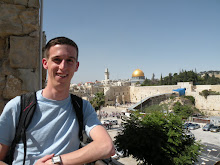
Hezekiah's Tunnel was built in 701 B.C. by King Hezekiah of Judah. They're unsure of its purpose, but it very well could have been a water source. It goes under the City of David (an area of Jerusalem) and empties out into the famous Pool of Siloam, where Jesus instructed the blind man to wash out the healing mud in his eyes in John 9:7. As you can see, this is me in the tunnel today. We waded through water that was almost knee-deep at points, but we were prepared with swimsuits and headlamps! It was incredible to walk through a 2,700-year-old tunnel.

In Israel, everyone is required to serve a minimum of two years in the army right after high school. Thus, there are hundreds of soldiers walking around the city armed with M16s. They're not to be feared, as Jerusalem is a pretty safe city (relatively speaking), and they're there to protect people who aren't causing trouble. Plus, as you can imagine, most of them are 19 or 20 years old, younger than I am! It's kindof a "Wheaton in the Holy Lands" tradition for the guys to take a picture with all the Israeli women soldiers. You see me here with some very kind soldiers -- they taught me some Hebrew, too! Toda raba! (Thank you very much!) Note that in the foreground, one is taking a picture of us, too. It almost seems like they actually like taking pictures with random tourists! Guess it gives them some time off...

In this picture, I'm shooting down onto the City of David. The City of David is a part of the Eastern Hill of Jerusalem and represents the original city when David was king in Jerusalem. In reality, the Eastern Hill is much lower than the Mount of Olives to the east and the Western Hill to the west. Even at the highest point of the City of David, you are surrounded by hills. Standing in this place, new and vibrant life is now given to Psalm 121 - "I lift up my eyes to the hills - where does my help come from? My help comes from the Lord, Maker of heaven and earth." As we stood in David's (the Psalm writer's) perspective, all we could see around us was hills. We were surrounded, vulnerable to attack. But where does our help come from? From the Lord! And being in the valley, none of the breezes reach us, so we want shade! As Eastern oriented people, the ancient Semites (Jews, which included David) would have been shading the hot sun from the southeast with their right hand. Bu in verse 5, we see that the LORD is the shade at our right hand. The Lord is the ultimate Provider and Protector. Here, this truth of God is communicated and grounded in the allegory of the real-life land. A wonderful example of text and land interaction. We also understand Psalm 125:1-2 now: Mount Zion refers to the City of David, and the mountains really do surround Jerusalem - just as the Lord surrounds us.
In the background, you can see the hills of Moab, Ruth's land of origin. The fog you see is over the Dead Sea, about 14 miles away. So we have the southern edge of the Mount of Olives on the left, the City of David in the center at the very bottom, and the confluence of the Hinnom and Kidron Valleys in the direct center of the picture.

No comments:
Post a Comment